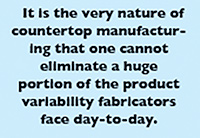Lean Malpractice: Prematurely Applying Single Piece Flow
Rick Phelps
Synchronous Solutions
For decades, Lean Manufacturing has had a huge presence in the manufacturing continuous improvement space, and for decades it has largely failed to deliver results to the bottom line of many businesses.
Lean’s roots are largely linked to Toyota and their highly regarded Toyota Production System.
Yet, does Toyota do ‘Lean’? No, not really. At least not as American companies try to do.
Toyota has applied the scientific method to their business, from top to bottom, and end to end. Every aspect of the Toyota system is set up as an on-going experiment from which to learn. The system ensures that countermeasures are taken to mitigate issues and problems as they are encountered.
Single Piece Flow is one of the primary targets of Lean.
Single piece flow is an ideal to be strived for – the ultimate end goal of a process that has eliminated variability.
Back in the 80s and 90s, Toyota production lines ran at 80+% capacity. Through relentless experimentation, application of countermeasures, and elimination of variability Toyota now manages even better performance. Awesome work, and a huge competitive advantage. But note: Toyota does not attempt to run their factories at actual capacity… Their system requires a small amount of unused capacity to absorb systemic variation.
 Some fabricating shops have been sold a ‘Lean’ bill of goods and attempted to leap to single piece flow without doing the decades of work required to eliminate variability in their processes (and their businesses).
Some fabricating shops have been sold a ‘Lean’ bill of goods and attempted to leap to single piece flow without doing the decades of work required to eliminate variability in their processes (and their businesses).
It is in the very nature of custom countertop manufacturing that one cannot eliminate a huge portion of the product variability faced day-to-day. This variability is accommodated by the deliberate maintenance of unassigned capacity. The CUSTOM nature of the products produced requires flexibility and uncommitted capacity. For this reason, implementing single-piece-flow in a custom products environment can never yield the outcomes of the high-capacity utilization realized in repetitive manufacturing.
It is a mistake to think that one can skip the work, yet reap the results.
Synchronous Flow is the process used to manage the flow of manufacturing and steadily improve. It too has been around for decades, first broadly explained in the book The Goal, by Eli Goldratt, published in 1984.
Synchronous flow is the application of Goldratt’s methods to manufacturing. It recognizes that every set of dependent processes has a weakest link (least capacity resource) – the clear Constraint of the system. Recognizing that weak link, it seeks to maximize the flow through that link (constraint), while taking into consideration the reality of variability.
In the same way that the weakest link in a chain defines the strength of the chain, the least capacity resource (constraint) defines the highest rate of flow through a system.
The process to manage flow is called Drum-Buffer-Rope, or DBR for short. DBR regulates the flow through the system at the Drumbeat of the Constraint, moving information or material through that Constraint at its maximum flow rate. BUFFER is the inventory of work positioned before the DRUM (Constraint) to make sure it never starves and can always produce at its optimum rate. The ROPE is the tie back from the DRUM to the release point, making sure flow into the system happens at the same rate it flows through the Constraint. This rope also minimizes inventory in the system driving down confusion and cost.
Let’s look at a feature of DBR that should be VERY attractive to countertop fabricators. The LEAN system must run at only a percentage of the system’s capacity to keep from entering a chaotic state, a state that naturally occurs due to the balanced nature of Lean system design. DBR is designed to run at the MAXIMUM rate of the Constraint and therefore, as said above, the maximum rate of the system, by design.
Now for the irony. DBR achieves a form of single piece flow. While there are a number of procedural differences, however, DBR achieves the highest level of productivity without having the need for the insurance of unused capacity.
If your company has implemented Lean in the fabrication shop and has not seen the benefit in the bottom line, or worse, jumped to single-piece-flow and put the production process into a chaotic state, don’t worry; the investment in Lean has not been wasted.
Implementation of DBR will provide the “time and place” information for profitable use of the Lean tools. Synchronous Flow and DBR is a proven and effective way to focus your continuous improvement efforts in the parts of your business that truly matter – the parts that translate into more dollars on your bottom line.
If you want help to accelerate the learning process for your business, give us a call. Our Synchronous Flow Operating System is designed to make everyone in your business a successful business scientist, learning and improving every day. Contact us at www.synchronoussolutions.com .
Rick Phelps – Synchronous Solutions